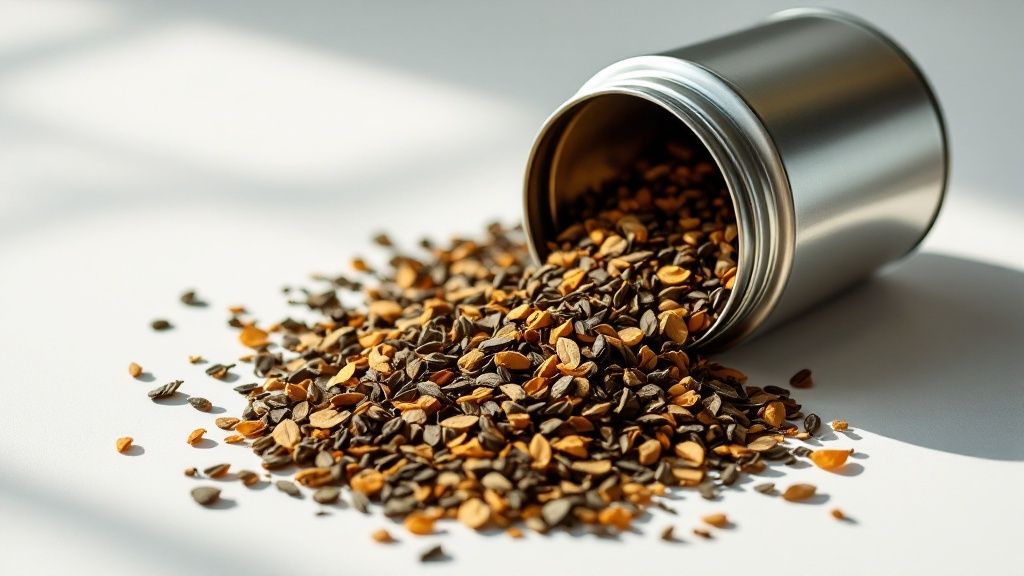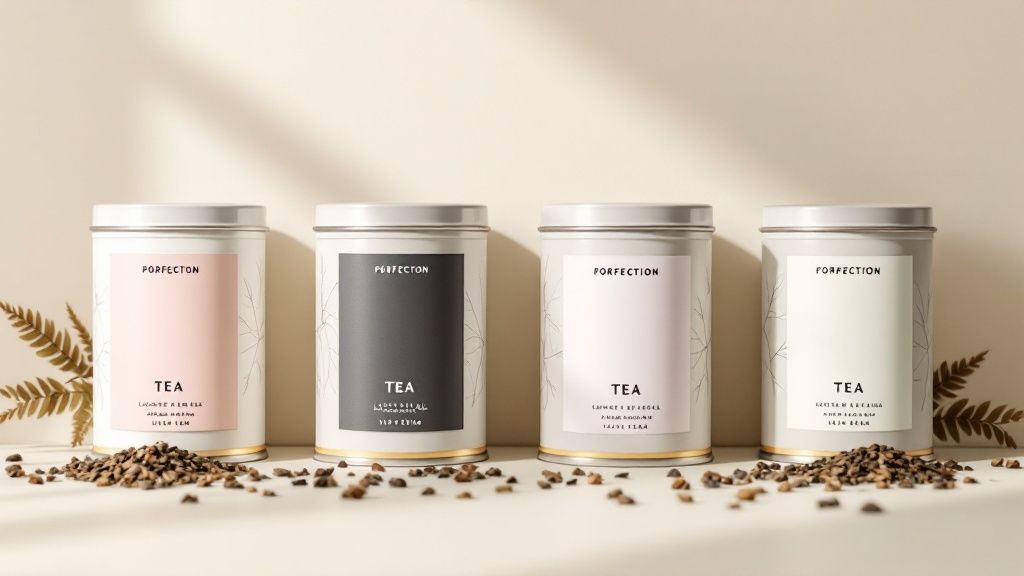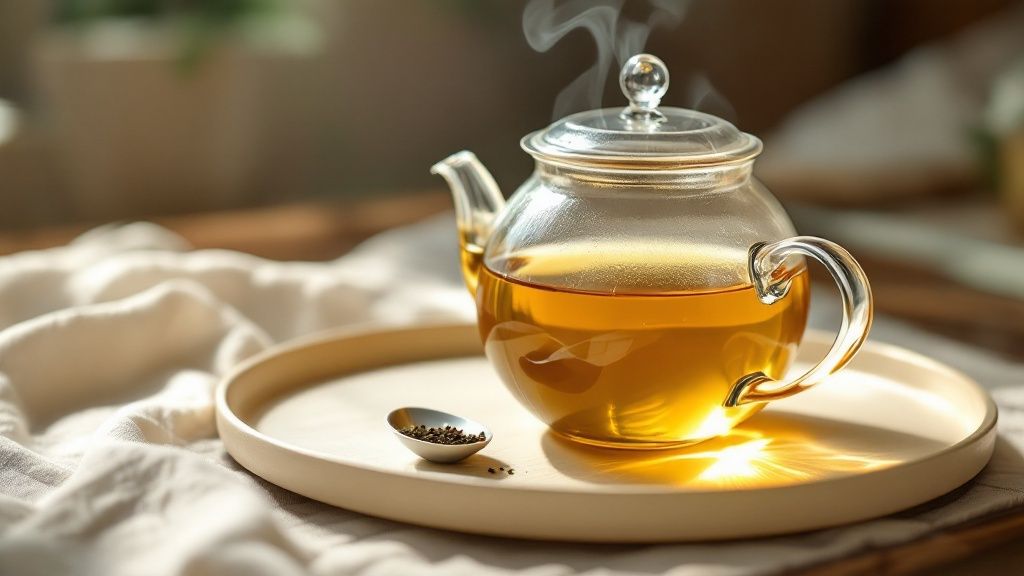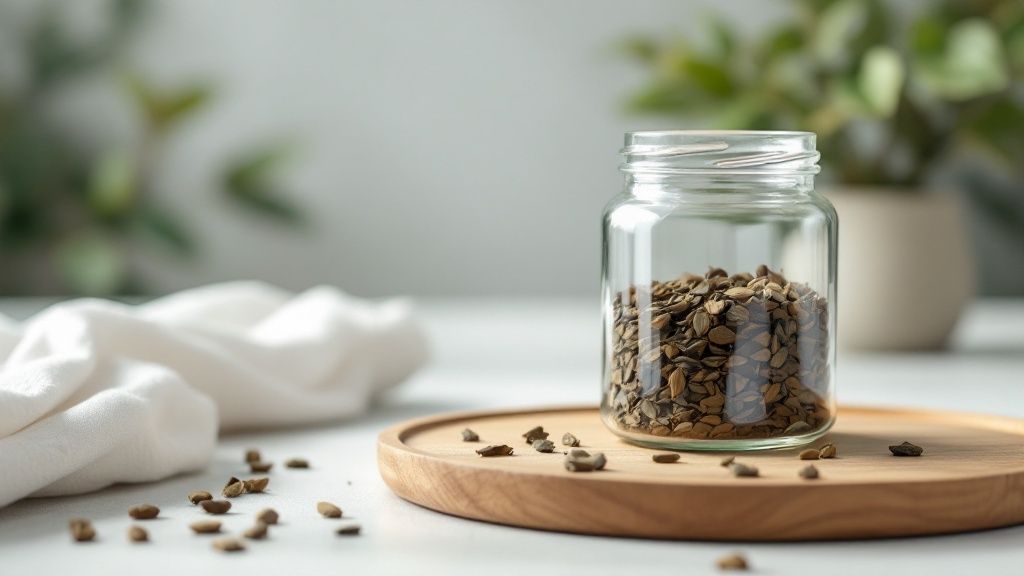So, you're on the hunt for the best loose leaf tea the UK has to offer? You've come to the right place. The finest teas almost always feature whole, unbroken leaves from ethical sources. Brands like Jeeves & Jericho and other artisanal specialists are leading the charge, putting quality far ahead of mass production. Your perfect cup really depends on what you fancy—a bold black tea, a delicate white, or maybe a complex oolong.
Your Journey into the World of Loose Leaf Tea

Welcome to your guide to the UK's brilliant loose leaf tea scene. We're leaving the humble teabag behind to explore the incredible flavours, aromas, and mindful rituals that only a quality loose leaf brew can provide. Think of this as your roadmap to a far more satisfying cuppa.
More and more British tea drinkers are making the switch. It seems we're all looking for better taste and a real connection to what we're drinking. The difference is something you'll notice straight away. Unlike the dusty "fannings" that fill most teabags, loose leaf tea is made of whole or large pieces of leaves. This means they hold onto their essential oils, which unlocks a much richer and more nuanced flavour.
Why Make the Switch to Loose Leaf
This shift isn't just a fleeting trend; it’s a sign that we’re starting to appreciate real quality and craftsmanship here in the UK. This has nudged even the big brands to start offering better loose leaf selections. The UK tea market is huge, with sales revenue predicted to hit around £2.1 billion annually by 2029, and loose leaf is grabbing a bigger and bigger slice of that pie.
This guide is here to give you the confidence to navigate this exciting world. We'll walk you through:
- The Essential Tea Categories: Getting to grips with the key differences between black, green, white, oolong, and Pu-erh teas.
- How to Spot Genuine Quality: Learning the little visual and aromatic clues that set a premium tea apart from the average.
- The UK's Standout Brands: Discovering the ethical and artisanal producers who are truly passionate about their craft.
- The Simple Art of Brewing: Mastering the basics to get the perfect flavour from your leaves, every single time.
By the time you're done here, you won't just know why loose leaf tea is better—you'll feel ready to pick out and brew blends that are just right for you. For a deeper dive, you can learn more about the benefits of loose leaf tea in our detailed article.
This isn't about becoming a tea snob overnight. It's about turning a simple daily ritual into a moment of pure enjoyment. Let's get started.
Getting to Grips with the Five Main Types of Tea
Before you can find the best loose leaf tea in the UK, it helps to know what you’re looking for. Here’s a little secret: every type of tea, from the boldest black to the most delicate white, comes from the exact same plant: Camellia sinensis.
So how do we get such a dizzying array of flavours, colours, and aromas? It all comes down to a single, crucial process: oxidation.
Think of what happens when you slice an apple and leave it on the counter. The flesh starts to brown as it reacts with the air. Tea leaves do the same thing. The art of the tea master is in controlling this process—how long it happens, or if it happens at all. This is what gives us our five main categories of tea.
Let's break them down.
Black Tea: The Nation's Favourite
Black tea is fully oxidised, which is what gives it that deep, dark colour and robust, malty character we know and love. After picking, the leaves are rolled to break down their cell walls, which kicks off an extended reaction with oxygen. This develops those complex flavours, which can be anything from sweet and fruity to rich and smoky.
It's the backbone of classic British cuppas like English Breakfast and Earl Grey. Its bold personality means it can easily stand up to a splash of milk and a bit of sugar, making it the comforting, go-to brew for millions.
Green Tea: Vibrant and Fresh
At the other end of the scale, you have green tea. Here, the goal is to prevent oxidation entirely. As soon as the leaves are picked, they're quickly heated to stop the process in its tracks. This is usually done by steaming (common in Japan) or pan-firing (the preferred Chinese method).
This simple step locks in the leaves' beautiful green colour and preserves their fresh, grassy, and sometimes nutty flavours. Without the malty depth of black tea, a good green tea offers a lighter, more delicate experience. High-quality varieties like Dragon Well or Sencha deliver a clean, refreshing taste that feels both uplifting and calming.
White Tea: Subtle and Delicate
White tea is the minimalist of the tea world—it’s the least processed of them all. It's made using only the youngest, most tender buds of the tea plant, which are often still covered in a fine, silvery-white down. The leaves are simply withered and dried with as little handling as possible, preventing almost any oxidation.
The result is a tea that’s incredibly subtle, with a pale, champagne-coloured brew. The flavour is light and sweet, often with whisper-soft notes of flowers, fruit, or honey. It’s the perfect choice for a quiet moment when you want something genuinely gentle and refined.
Oolong Tea: The Complex Middle Ground
Oolong is where the real artistry of tea-making shines. It sits in that fascinating space between green and black teas because it's only partially oxidised. The oxidation level can range from just 10% all the way up to 80%, creating an absolutely enormous spectrum of flavours.
- Lightly Oxidised Oolongs: These are closer to green teas, with wonderfully fresh, floral, and creamy notes.
- Heavily Oxidised Oolongs: These lean towards the black tea end of things, developing rich, roasted, and fruity characteristics.
Brewing a good oolong is a real treat. The leaves, often tightly rolled into little balls, will unfurl over multiple steepings, revealing new layers of flavour with every single cup.
Pu-erh Tea: Aged and Earthy
Pu-erh (or Pu'er) is a completely different beast. It’s a fermented tea, not just an oxidised one. Hailing from China's Yunnan province, the leaves go through a microbial fermentation process before being aged, often for many years, just like a fine wine.
This ageing process transforms the tea, smoothing out its character and developing incredibly deep, earthy flavours.
Pu-erh offers a taste experience unlike any other tea. It's often described as smooth, rich, and mellow, with notes of damp forest floor, old wood, or even mushroom. It is prized by connoisseurs for its complexity and is well-regarded for its digestive properties.
Before we move on, here's a quick cheat sheet to help you keep these categories straight.
A Quick Guide to Loose Leaf Tea Types
This table gives a quick snapshot of the main tea categories, helping you compare them at a glance.
| Tea Type | Flavour Profile | Caffeine Level | Ideal Water Temperature |
|---|---|---|---|
| Black | Malty, robust, fruity, smoky | High | 90-100°C |
| Green | Grassy, vegetal, nutty, fresh | Low to Medium | 70-80°C |
| White | Delicate, floral, honeyed, sweet | Very Low | 65-75°C |
| Oolong | Floral and creamy to roasted and fruity | Medium | 85-95°C |
| Pu-erh | Earthy, woody, mellow, rich | Medium to High | 95-100°C |
Getting to know these foundational types is the best first step toward finding a brew you'll truly fall for. If you want to go a bit deeper, you can explore the different types of tea and their unique characteristics in our more comprehensive guide.
How to Spot High-Quality Loose Leaf Tea

Dipping your toes into the world of loose leaf tea can feel a bit much at first. You’re faced with a dizzying array of options online and in specialist shops all over the UK. How do you know if you’re picking a genuinely brilliant tea? The good news is, you don’t need to be a seasoned expert. You just need to know what to look for.
A great tea will always appeal to your senses. By simply paying attention to what the dry leaves look, smell, and even feel like, you can start to tell the premium stuff from the not-so-great. It’s a skill that, once you’ve got the hang of it, gives you the confidence to pick a winner every time.
Think of it like choosing fruit and veg at the market. You know a crisp, vibrant apple from a dull, bruised one just by looking at it. The same intuition applies here; we’ll show you exactly which signals to tune into.
The Visual Cues of a Superior Tea
Before a drop of water even touches the leaves, your eyes can tell you a huge amount about the quality of a tea. Tip a little out and have a proper look at the leaves themselves. The very first thing to check is their integrity.
Proper loose leaf tea should be made up of whole, unbroken leaves. You ought to be able to see the distinct shape, whether it's the long, wiry twists of a Darjeeling or the tightly rolled pearls of an oolong. This is a dead giveaway that the tea has been handled with care right from the moment it was picked.
On the other hand, a low-quality tea is often full of tiny, broken bits and a fair bit of dust. These fragments, known in the trade as "fannings" and "dust," are the leftovers from processing higher-grade leaves and are exactly what you find in most paper teabags. They brew fast, sure, but they also release a rush of tannins, which often leads to a bitter, one-note cuppa.
Here are the key things to look out for:
- Whole Leaves: The number one indicator of quality. Are the leaves intact?
- Uniformity: The leaves should look like they belong together – consistent in size, shape, and colour. A jumble of different sizes will brew unevenly.
- Colour: You’re looking for vibrant, rich colours that feel alive. A good green tea should be a lovely green, not a sad, brownish-yellow.
- Absence of Stems: A few little twigs are perfectly normal, but a bag full of them suggests a less-than-careful harvest.
As a simple rule of thumb: the bigger and more complete the leaf, the more complex and nuanced the flavour in your cup. Whole leaves unfurl slowly, releasing all their aromatic oils and flavours in beautiful layers.
Trust Your Nose: The Importance of Aroma
Right, after you’ve had a good look, it’s time to use your nose. The scent of the dry leaves is a massive clue to their freshness and quality. A top-notch loose leaf tea will have a distinct, inviting, and complex fragrance that grabs your attention straight away.
Bring a pinch of tea up to your nose and take a deep breath. What do you get? A quality black tea might give you notes of malt, dried fruit, or even honey. A fresh green tea should smell bright and grassy, maybe with a hint of toasted nuts or the seaside.
If it smells faint, dusty, or just a bit flat, it’s probably old or has been stored badly. Air, light, and moisture are the enemies of good tea. A weak aroma is a sure sign that all those lovely volatile compounds that create the flavour have already vanished. When you’re hunting for the best loose leaf tea in the UK, never underestimate a fresh, enticing scent.
Understanding Sourcing and Transparency
Finally, a real hallmark of exceptional tea is transparency. The best tea brands are proud of where their tea comes from and are keen to share its story with you. This isn't just marketing fluff; it's your guarantee of authenticity and quality control.
Look for details about the tea's origin. A good supplier won't just say the country; they'll often tell you the specific region, the estate, or even the harvest season (like a "First Flush Darjeeling"). This level of detail shows they have a direct link to the people who grew it and a real commitment to quality.
When a brand can trace its tea right back to a single estate, it’s a very strong signal that you’re about to enjoy a premium, carefully curated product.
Navigating the UK’s Top Tea Brands and Retailers

Alright, you've got the basics down on what makes a good tea. Now for the fun part: where do you actually find the best loose leaf tea the UK has to offer? The British tea scene is buzzing, a brilliant mix of centuries-old institutions and passionate independents. Finding your go-to brand is all about matching their vibe with your own tastes and values.
To help you get started, we've broken the landscape down into three main groups. Whether you're hunting for a rare, single-estate gem, a classic comfort blend, or a brew that does some good in the world, there's a UK brand with your name on it.
And it’s not just us—the UK's love for proper tea is growing. Europe, including the UK, makes up over 30% of the world's entire market for loose leaf tea. In fact, around 35% of tea drinkers now prefer loose leaf to bags. With online shopping becoming the norm, a huge 64% of global tea sales happen online, a trend we're definitely seeing right here at home.
Artisanal and Independent Specialists
These are the heart and soul of the UK’s modern tea scene. Think small, passionate outfits, often run by dedicated experts who’ve travelled the globe to shake hands with the people growing their tea. They’re all about sourcing unique, small-batch leaves that you just won’t find on a supermarket shelf.
What really sets them apart is the story. When you buy from an independent, you're not just getting a bag of tea; you're getting a connection to a specific farm, a particular harvest, and the skilled people who made it happen. This is where you go to find the really interesting stuff and push your palate.
- What to Expect: Single-origin teas with detailed tasting notes, creative new blends, and a real focus on freshness and what’s in season.
- Ideal For: The curious tea drinker who gets a kick out of discovering new flavours and learning the story behind the brew.
Lots of these specialists also supply amazing cafes and restaurants. If that side of the business piques your interest, our guide on finding wholesale tea suppliers in the UK is a great place to start.
Established Heritage Brands
These are the household names, the brands that have defined British tea culture for generations. With decades—sometimes centuries—of history, they've mastered the art of delivering consistent quality on a much bigger scale. While they might not offer the quirky, single-estate batches of the smaller guys, they are masters of reliable, beautifully crafted blends.
Heritage brands are brilliant at creating those perfectly balanced and comforting brews, like a classic English Breakfast or a fragrant Earl Grey. Their skill lies in sourcing leaves from different estates and blending them to create that signature flavour that tastes exactly the same, year after year. For a high-quality daily cuppa, you can’t go wrong.
Their staying power is a real testament to their blending mastery. They offer a familiar comfort and a guarantee of quality that people have trusted for a very, very long time.
Ethical and Sustainable Champions
For many of us, knowing where our tea comes from is just as important as how it tastes. A growing wave of UK brands are putting ethical sourcing and sustainability right at the centre of everything they do. These companies go way beyond a simple certification sticker, focusing instead on building fair, supportive partnerships with tea-growing communities.
These champions focus on fair wages, supporting local projects, and using farming methods that are kind to the planet. They often work with organic farms and are completely transparent about their supply chain, letting you trace your tea right back to the garden. It's also worth noting that many top brands invest in high-quality packaging products to keep their tea fresh, often using recyclable or compostable materials to complete the circle.
Choosing an ethical brand means your morning brew is actively helping to build a fairer, more sustainable tea industry. It’s about enjoying a truly delicious cup of tea that you can feel fantastic about drinking.
-
Key Certifications to Look For:
- Fairtrade: Guarantees farmers get a fair price for their crop.
- Rainforest Alliance: Promotes biodiversity and supports sustainable livelihoods.
- Organic (e.g., Soil Association): Ensures tea is grown without synthetic pesticides or fertilisers.
By exploring these different types of brands, you’ll be well on your way to finding a UK tea company that not only makes a brilliant brew but also feels just right for you.
Mastering the Simple Art of a Perfect Brew
Having a brilliant tea in your cupboard is one thing, but knowing how to brew it is where the magic really happens. Forget any intimidating rituals or complicated instructions you might have heard. A truly perfect cup comes down to just four simple things: the water, its temperature, how much leaf you use, and how long you let it steep.
Nailing these fundamentals is what will completely transform your daily brew. It’s the difference between a flat, bitter cuppa and one that’s alive with nuanced flavour and aroma. Think of yourself as the conductor of a tiny orchestra—each element has to be just right for the final performance.
The Foundation: Water Quality
It might sound a bit over the top, but the water you use makes a massive difference. After all, your tea is about 99% water, so its quality has a direct line to the final flavour. In the UK, we often have to deal with hard tap water, which is packed with minerals that can make tea taste dull and even look a bit cloudy.
For a brew that really sings, try using filtered water. A simple filter jug is all you need to strip out the impurities that get in the way of your tea's delicate notes. You’ll notice the difference straight away – a cleaner, brighter taste that lets the tea’s true character shine through.
Getting the Temperature Just Right
This is probably the most common slip-up. Pouring boiling water straight onto delicate leaves is the fastest way to ruin a good tea. It literally scorches them, releasing bitter-tasting tannins and killing all the subtlety. Different teas need different temperatures to gently coax out their best flavours.
Getting the temperature right is essential for any hot drink; for instance, understanding the correct temperature for coffee is just as vital for unlocking its full potential. The same principle applies here.
Here’s a quick guide to get you started:
- Black & Pu-erh Teas (90-100°C): These robust, hearty leaves can take the heat. Use water just off the boil to draw out their deep, malty character.
- Oolong Teas (85-95°C): A slightly cooler temperature helps their complex, layered flavours unfold without any harshness.
- Green Teas (70-80°C): This is the crucial one. Water that's too hot will scorch these delicate leaves in an instant. Let the kettle cool for a minute or two after it clicks off.
- White Teas (65-75°C): As the most delicate of all, these need the gentlest touch. Cooler water protects their subtle, sweet, and floral notes.
A variable temperature kettle is a brilliant investment for any tea lover. If you don't have one, no stress – just let a boiled kettle stand for a few minutes to cool down.
The Perfect Leaf-to-Water Ratio
Next up is measuring your leaves. While it sounds very scientific, think of this more as a starting point than a strict rule. A great general guideline to aim for is one teaspoon of tea (around 2-3 grams) for every 200ml cup of water.
Of course, this can change depending on the tea. A light, fluffy white tea might need a more heaped teaspoon, whereas a cup of dense, tightly rolled oolong will need less. Don't be afraid to play around. If your brew feels a bit weak, add a little more leaf next time. Too strong? Just dial it back a bit.
Timing Your Steep Perfectly
The final piece of the puzzle is the steeping time. This is your last point of control over the strength and flavour of your tea. Leaving it to infuse for too long is an easy mistake to make, and it’s what often leads to that astringent, mouth-puckering taste.
- Black Teas: 3-5 minutes
- Green Teas: 1-3 minutes
- White Teas: 2-4 minutes
- Oolong Teas: 2-5 minutes (these vary quite a bit!)
Get a timer on your phone! It’s the simplest way to get a consistent brew every time. And remember, one of the best things about good quality loose leaf tea is that it can be re-steeped multiple times. Each new infusion will reveal slightly different, subtle layers of flavour.
A Few Final Questions on Loose Leaf Tea

Diving into the world of loose leaf tea for the first time can bring up a few questions. That's completely normal. Here are some straightforward answers to the most common queries, designed to get you brewing with confidence.
Is Loose Leaf Tea Stronger Than Tea Bags?
It's not necessarily about a bigger caffeine hit, but it is a world away in terms of flavour and aroma. Because loose leaf tea uses whole or large-cut leaves, it unfurls in the water to release a far more complex and nuanced taste. You just don't get that depth from the finely-cut tea 'dust' in most teabags.
How Long Does Loose Leaf Tea Stay Fresh?
If you store it properly, most loose leaf tea will stay wonderfully fresh for about one to two years. The key is to keep it in an airtight container, away from light, in a cool, dark spot. Of course, there are exceptions – aged teas like Pu-erh actually get better over time!
Think of your tea's biggest enemies: air, light, moisture, and any strong smells lurking in your cupboards. A simple airtight tin is the best defence, keeping every cup as flavourful as the first.
Do I Need a Special Teapot to Brew Loose Leaf Tea?
Not at all. While a beautiful teapot is a lovely thing to have, you don't need one to get started. The easiest way to begin is with a simple basket infuser that sits right in your favourite mug. It gives the leaves plenty of room to expand and is incredibly easy to clean up afterwards.
Can I Re-steep Loose Leaf Tea Leaves?
Absolutely! In fact, you're supposed to. High-quality leaves, especially Oolongs and many Green teas, are crafted to be infused multiple times. Each steep coaxes out different, subtle notes from the leaves. It's a fantastic, and very economical, way to get the most out of your tea.
Ready to find your perfect brew? At Jeeves & Jericho, we travel the world to source exceptional whole leaf teas, bringing the finest flavours right to your cup. Explore our curated collection and start your journey at https://www.jeevesandjericho.com.


